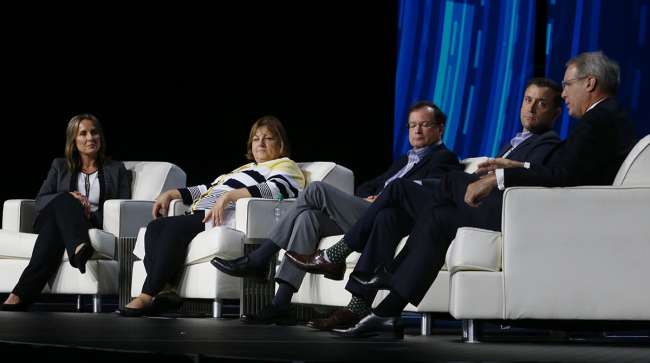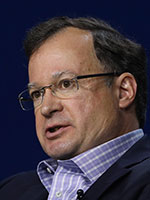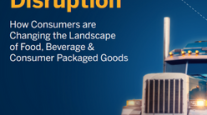Senior Reporter
No Quick Fix in Sight to Move Freight, Panelists Say

[Stay on top of transportation news: Get TTNews in your inbox.]
NASHVILLE, Tenn. — Fixing the severely kinked supply chain will take well into 2022, requiring unprecedented cooperation among trucking, freight rail, ocean carriers, ports and shippers. Those were some of four experts’ conclusions during a panel discussion Oct. 25 at American Trucking Associations’ Management Conference & Exhibition.
“The problems we are having here in terms of port and inland congestion, the difficulties in getting labor and keeping cargo and equipment moving as opposed to sitting still, these things are happening all over the world,” World Shipping Council President John Butler said. “For all of this to unwind, at least from the ocean shipping side, we need to see improvement in ports all over the world, pretty much at the same time.”
The Southern California facilities at Los Angeles and Long Beach are gaining most of the attention regarding the supply chain tie-ups. Yet Association of American Railroads President Ian Jefferies said freight rail hubs, including Chicago, have had a backlog since at least spring, which in turn is causing problems for trucking, as the two sectors often cooperate on freight delivery.

Jefferies
“At one point, one railroad had 20 intermodal trains waiting outside its Chicago terminal just to go in and unload because there were so many containers they could not get out,” Jefferies said. “Some pretty dramatic steps were taken to increase capacity, storage capacity around the center part of the country, trying to motivate pick-ups in off-hours, but it’s an ongoing battle.”
The panelists — Butler, Jefferies, American Trucking Associations President Chris Spear and National Shippers Strategic Transportation Council Executive Director Gail Rutkowski — saluted the White House for its efforts to encourage 24/7 operations at the ports of Long Beach and Los Angeles.
AAR’s Jefferies said a 24/7 supply chain is not a panacea, and there needs to be more cooperation and transparency among trucking and railroad and ocean carriers to make all modes run smoother.
“I think more transparency is helpful to the extent we can do it,” Jefferies said. “We don’t always know who the beneficial cargo owner is, and if you have a sense of where that end destination is for the container, so maybe you put all the cargo for one BCO in one spot in the yard. There are any number of steps that can be taken, information sharing about where there is available capacity.”

Rutkowski
Rutkowski added: “I think this stems back to developing trust and good lines of communications with your transportation partners. This is something we preach all the time with our shippers, especially now. The shippers that have had and built those relationships with their providers are the ones that are being most successful navigating those troubled waters.”
Trucking, rail, and shipping officials say that due to the COVID-19 pandemic and the enormous changes in buying habits by consumers, all modes of transportation are moving record amounts of cargo. WSC’s Butler told the audience that there is now enough capacity to move the current freight under optimal conditions.

Butler
“Nobody is happy about how we’re managing this. Everyone here is moving more freight than ever before. The problem is because of the congestion; we are moving it in a very inefficient way,” he said. “At a port, you might be picking up three containers to get to one to put it on a train. That’s not speeding up the process.
“Where do we find a chassis? When you put all those impediments into the process, you slow down the entire supply chain.”
Spear said that in the future he is concerned about the impact the White House executive order mandating COVID-19 vaccines for companies with more than 100 employees may have on the supply chain if trucking does not obtain an exemption.
If you look at the role of a driver, they’re very independent, and that’s reflected in the number of drivers who said they would leave that employer if it’s mandated.
ATA President Chris Spear
“Looking at our workforce, we’ve gone to great lengths to look at the infection rate and the mortality rate,” he said, “It is extraordinarily low, and that should not come as a surprise to anybody, including the administration. If you look at the role of a driver, they’re very independent, and that’s reflected in the number of drivers who said they would leave that employer if it’s mandated.”
Spear said the mandate would put more pressure on the supply chain when those on the panel said it already is stretched thin.
For the most part, the panelists agreed that there is no one quick fix to get the supply chain back up to speed, and NSSTC’s Rutkowski said now that the supply chain’s flaws have been exposed, it’s time to rebuild.
“In my mind, we should not go back to normal because normal is not working now,” Rutkowski said. “I think we need to come up with a new normal and define what that is, together as a united supply chain.”
Want more news? Listen to today's daily briefing below or go here for more info:





